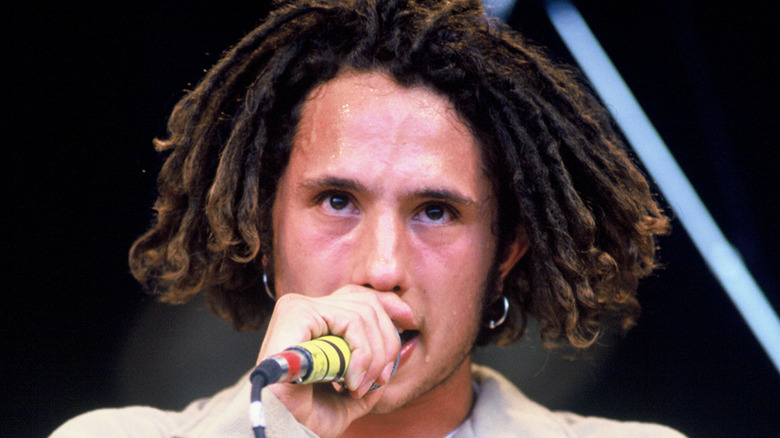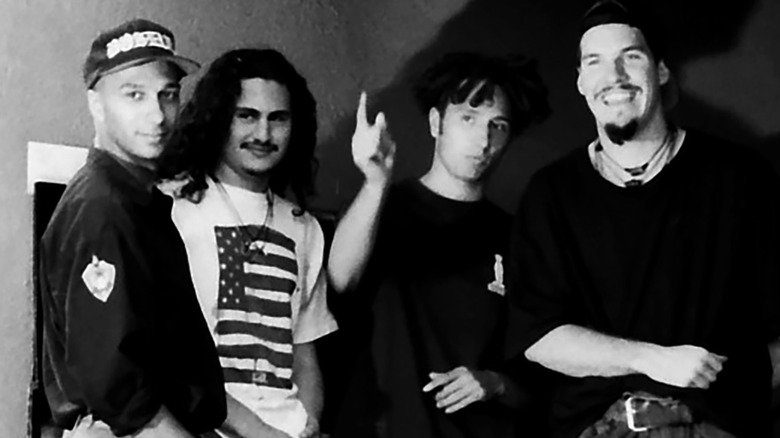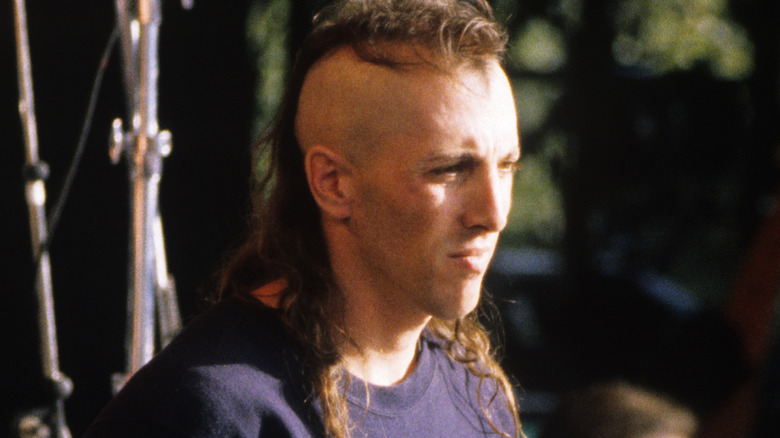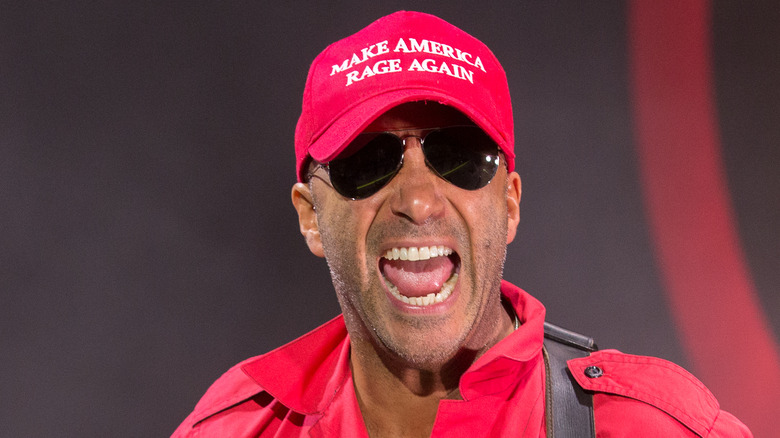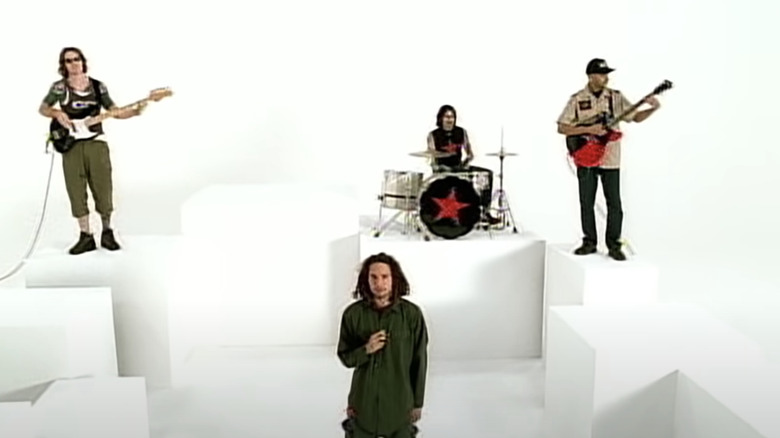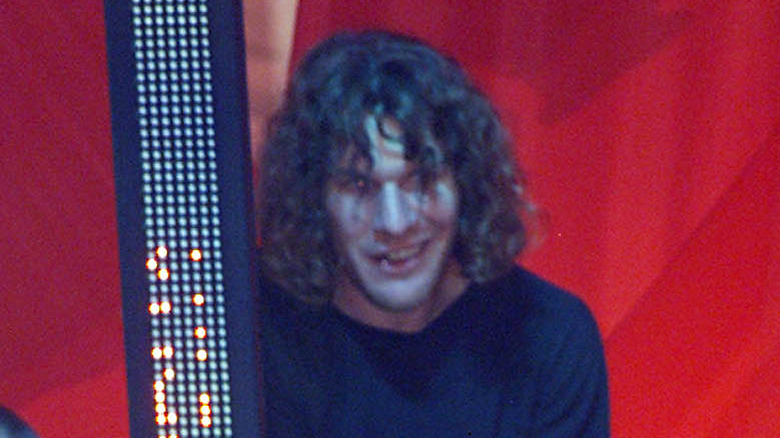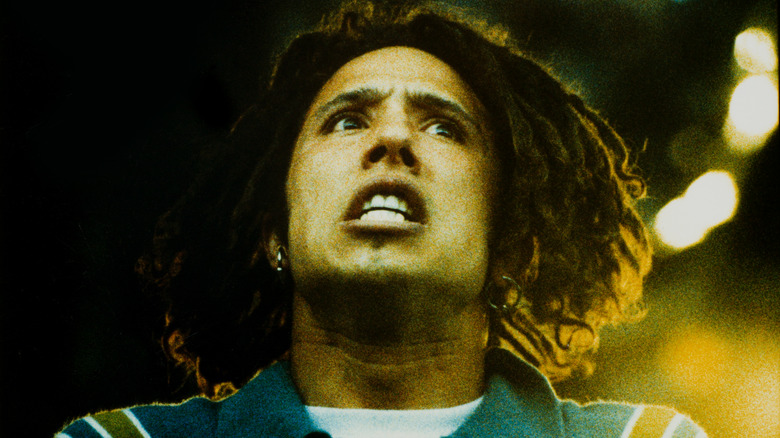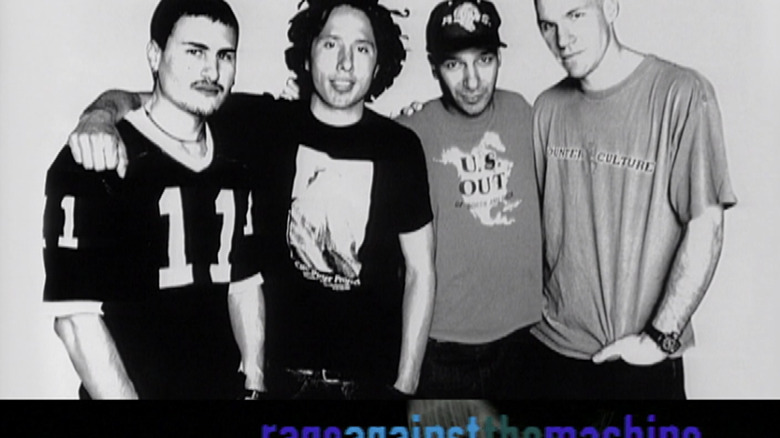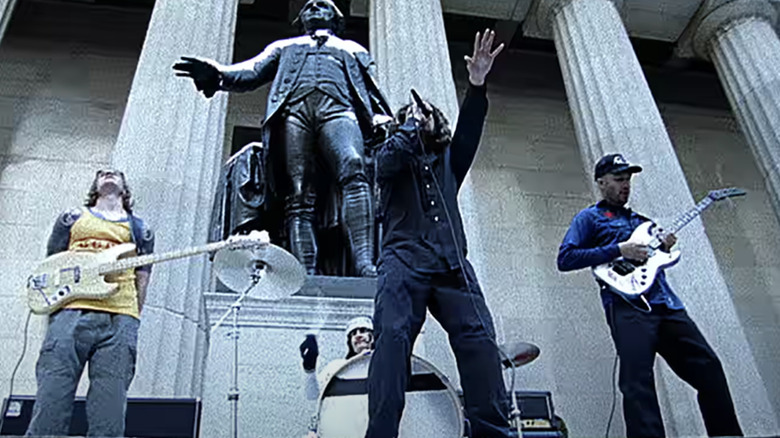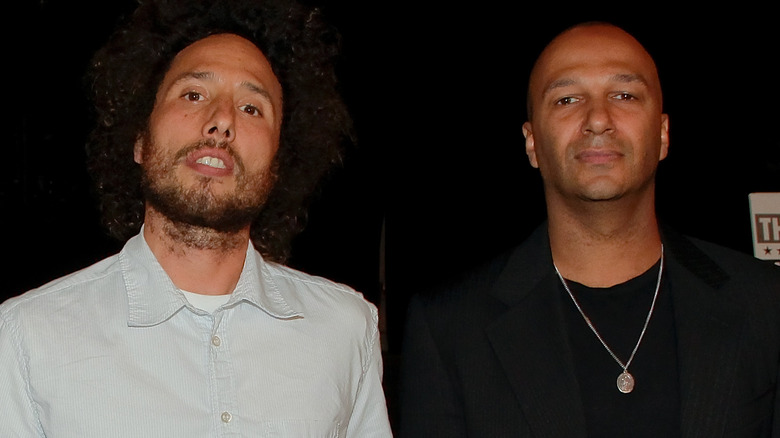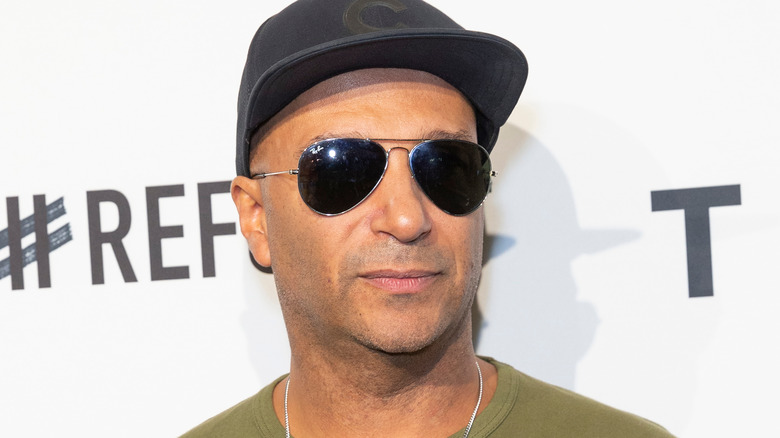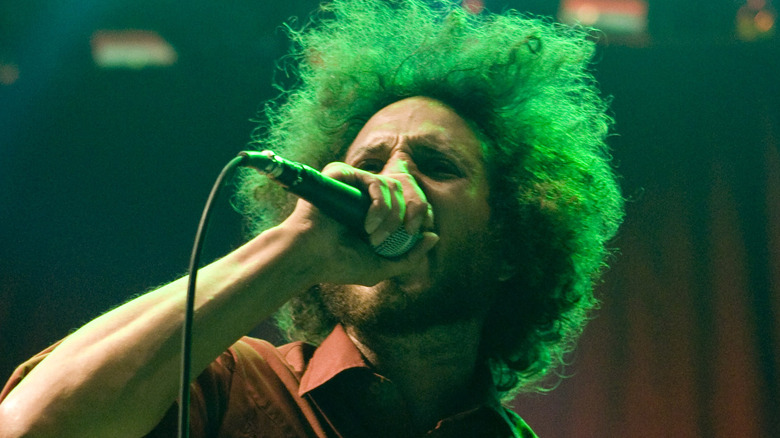The Untold Truth Of Rage Against The Machine
On the heels of the '80s, when rock bands sang about little more than partying and feeling good, along came Rage Against the Machine. With a nod to the protest rock of the '60s, but with way more intensity, the California quartet showed that rock music could be used as a vehicle for change, or to spread awareness of, and demand an end to, obscene injustice. Rage Against the Machine brought radical politics to rock and ironically became one of the most commercially successful bands of the 1990s. Led by rapper-slash-singer-slash-incendiary-poet Zack de la Rocha and innovative guitar idol Tom Morello, Rage knocked out a string of thoughtful, angry, change-advocating hits in its heyday, including "Freedom," "Bulls on Parade," "Killing in the Name," "Guerrilla Radio," "Sleep Now in the Fire," and "Bombtrack." They further influenced the philosophical and political leanings of their fans as well as the very sound of hard rock and rap-rock for decades to come.
Everything you didn't know about Rage Against the Machine is right outside your door. It has to start somewhere, so what better place than here, what better time than now?
Rage Against the Machine was formed amidst the end of other bands
According to Ebullition Records, Zack de la Rocha was part of a Southern California-based group called Inside Out, which released just one EP, and by the time it hit stores in the early 1990s, the group had already split up. Plans for a follow up called "Rage Against the Machine," named for a phrase Ebullition founder Kent McClard coined in an issue of his zine, "No Answers," subsequently fell apart, but de la Rocha liked the title of the nonexistent record enough to use it as the name of his next band.
Around the same time that Inside Out broke up, so too did another local band called Lock Up. That group's drummer, Jon Knox, was days away from moving away to Nashville to pursue a career in Christian music, according to OC Weekly, when he thought his friend, bass player Tim Commerford, should connect with Lock Up guitarist Tom Morello, thinking their musical styles would mesh. Knox gave Morello's contact information to Commerford and also suggested de la Rocha to meet up with those two.
The guy Knox out-auditioned for his spot in Lock Up: Brad Wilk, who, according to the podcast "Let There Be Talk" (via Ultimate Classic Rock), had just flunked his tryout to replace Dave Krusen as the drummer in Pearl Jam. He got the job in Rage Against the Machine instead.
They were against Maynard James Keenan of Tool
After former Lock Up guitarist Tom Morello started playing with bassist Tim Commerford, but before Zach de La Rocha or Brad Wilk evidently were involved yet, Rage Against the Machine nearly counted another member among its ranks. Maynard James Keenan, best known as the chief creative force between thoughtful metal bands Tool and A Perfect Circle, played with an early version of Rage. "We actually were in a rehearsal space — this is after ... Lock Up was dead and he was trying figuring out where he [was] gonna go next," Keenan told Rolling Stone. The musician thinks it didn't work out because he was in a quirkier place with his art than where the future Rage Against the Machine was, as he'd just come off of working on the novelty band Green Jellö. "They were looking for a more serious approach, so I think that was pretty much immediate. If there was a consideration for that at all, it was very brief."
Keenan would eventually team up with half of the final Rage Against the Machine lineup. For the 1994 Kiss tribute album "Kiss My Ass: Classic Kiss Regrooved," Keenan, Morello, and Wilk (with Faith No More bassist Bill Gould) covered "Calling Dr. Love" under the name Shandi's Addiction.
A very Rage Against the Machine Christmas
The first single Rage Against the Machine ever released: the caustic, anti-establishment, anti-racist, anti-police screed "Killing in the Name." Emerging in early 1993 off the band's first, self-titled debut record, the song didn't chart in the U.S. and made it to a respectable No. 25 in the U.K., but more than a decade later, it would become one of the most unlikely chart-toppers in history.
According to 1883 Magazine, scoring the No. 1 hit in the U.K. the week of Christmas is a big deal and a major milestone. Prominent artists and labels all vie and jockey and lobby to get their song to the top, and it's often a sentimental tune, a holiday song, or, as it was in the 2000s, the well-timed winner-coronating debut single from that year's edition of singing competition reality show "The X Factor."
Jon Morter, a 35-year-old DJ from Essex, thought it would be a fun prank to get a song diametrically opposite to a schmaltzy pop ballad to the top of the charts. In 2009, according to The Guardian, Morter launched a campaign to prevent Joe McElderry's big single from hitting No. 1 on Christmas in favor of Rage's "Killing in the Name." The idea went viral, and thanks to the public support of popular comedian Peter Serafinowicz, Paul McCartney, and, ironically, previous "X factor" champ Steve Brookstein, "Killing in the Name" sat at No. 1 on the U.K. pop chart on Christmas Day.
Nobody stages a thoughtful protest better than Rage Against the Machine
Rage Against the Machine's music could be characterized as protest rock — they are openly, blatantly, and specifically political, calling out injustice, inequality, and appalling inhumanity as they see it. Putting across such serious themes as its mission excuses the band from injecting much humor, levity, or satire into its songs, but Rage has made up for it in videos and performances, producing some boldly and viciously funny visual, meat-space protests.
At a 1993 Lollapalooza stop in Philadelphia, according to Uncut (via NME), Rage stood up to Tipper Gore's Parents' Music Resource Council, the censor-like music industry watchdog group which drafted the "Parental Advisory Explicit Content" album sticker (per Newsweek). The band didn't play a note and spent their entire allotted stage time standing on the stage, completely nude, with each letter of "PMRC" painted on a different group member's chest. Rage's 1999 single "Guerrilla Radio" calls out its perceived corporate puppetry of the American government, while the video for the song parodies Gap commercials of the era, depicting the band on a plate white stage, intercut with images of garment workers in sweatshop-like conditions, per MTV News. In response to 300 police officers protesting a Rage Against the Machine show outside Boston in 1999 (according to Kerrang, via Music Fan Clubs) because of the band's work to free Mumia Abu-Jamal, convicted of killing a law enforcement official, Morello sent doughnuts.
Tim Commerford is a one-man protest machine
In addition to participating in wholesome, whole-band protests for complex political and social causes, Rage Against the Machine bassist Tim Commerford isn't afraid of going a bit more brash to make known his personal profound displeasure, be it for an injustice big or small.
According to Far Out, Commerford helped build in the tension in Rage's performance of "Killing in the Name" at the Woodstock '99 festival. As singer Zack de la Rocha repeated the song's bridge, "F*** you, I won't do what you tell me" at an increasing volume and inciting the crowd to sing along, Commerford got busy, wandering over to some amps and, finding an American flag adorning some equipment, lit it on fire, igniting a towering blaze.
A little over a year later, Rage Against the Machine attended the 2000 MTV Video Music Awards, nominated for Best Rock Video for its clip for "Sleep Now in the Fire." They didn't win, losing to Limp Bizkit's "Break Stuff," according to Loudwire. Commerford registered his disappointment by climbing the scaffolding on the stage during Limp Bizkit's acceptance speech. Police arrested him afterward.
How Rage Against the Machine captured its vibe on record
Rage Against the Machine's art is music with a message, and for that message to get across — that there is something very bad going on in the world, and those responsible will not get away with it — a certain anxious, anger-fueled intensity is a requirement. Zach de la Rocha's vitriolic words and Tom Morello's loud, metallic guitar sound hammers that point, particularly at Rage Against the Machine live shows, which were often more protest or demonstration than entertaining rock n' roll concert.
Early in its life, the band realized that their recordings lacked something. "From the very first shows, the music always felt alive and powerful. We went into the studio to record, we were having a very difficult time capturing that," Morello told Spin. The way they fixed the issue: "We invited a bunch of friends into the studio and basically just played the set. So it was like a show." That means that about half of Rage Against the Machine's first, self-titled studio album was recorded live — a very unorthodox and rare production style.
Rage Against the Machine got kicked off of Saturday Night Live
In April 1996, Rage Against the Machine released its second album, "Evil Empire," the name coming from President Ronald Reagan's '80s era nickname for the Soviet Union, according to Zack de la Rocha (via MTV News). As part of the promotional drive, the group was booked to perform as the musical guest on "Saturday Night Live" on an episode hosted by a man who, like Reagan, wanted to be a Republican president of the United States: businessman and publisher Steve Forbes.
A political statement from the left-leaning band was almost inevitable. According to Rolling Stone, Rage Against the Machine's crew hung upside-down American flags — a highly critical symbol that suggests the U.S. is under distress or in a state of crisis — on the stage prior to the band's performance. "SNL" stagehands ripped the flags down seconds before the band tore into "Bulls on Parade." "As soon as we're offstage, the show's producer, Marci Klein informs our tour manager that there will be no second song," as is customary for musical guests, guitarist Tom Morello said. The band was ordered to immediately leave the building.
Rage Against the Machine closed down the stock market
To direct the video for "Sleep Now in the Fire," a single off of their 1999 album "The Battle of Los Angeles," Rage Against the Machine hired fellow truth-to-power-speaking documentary filmmaker Michael Moore. According to Colin Devenish's "Rage Against the Machine," band and director conspired to film without permits or permission on the street facing the New York Stock Exchange, a working symbol of the American corporate economy. "We decided to shoot this video in the belly of the beast," Moore said on a website posting at the time. Rage managed to play through the song six times with cameras rolling before police arrived to shut it down. "They ordered the makeshift concert to cease, but before we had a chance to stop, four officers jumped me and put me in one of those police locks," Moore recalled.
The crowd of 200 that had amassed to watch and support Rage Against the Machine retaliated by breaking through police-erected barricades and right into the anterooms of the New York Stock Exchange, with members of the band leading the charge. They were unable to get onto the trading floor, but they sent the NYSE into lockdown mode, with steel gates preventing anyone from getting in. The makeshift-concert-turned-protest also prematurely shut down commodities trading that day for about a couple of hours.
When Rage Against the Machine broke up and turned into Audioslave
The fourth and final Rage Against the Machine album: "Renegades," a 2000 collection of covers of bands that inspired Rage, including "Kick Out the Jams" (MC5), "How I Could Just Kill a Man" (Cypress Hill), and "The Ghost of Tom Joad" (Bruce Springsteen). Then, vocalist Zack de la Rocha left the band, informing guitarist Tom Morello at virtually the same time he issued a press release informing the rest of the world, according to Far Out. He'd actually been planning to take a hiatus as long as two years from the band but decided his departure would be permanent. According to both de la Rocha and Morello, creative differences had simply boiled over. "It's not unique among rock bands to find the occasional dissension," de la Rocha said, with Morello explaining that "There's been a constant tension that's been an enormous challenge for us all over the years."
Morello, Tim Commerford, and Brad Wilk quickly reconvened as a less-political, more radio-friendly hard rock band called Audioslave, recruiting Soundgarden belter Chris Cornell to be its frontman (via AllMusic). The new group sold millions of copies of its three albums before splitting up, only for the three non-Cornell members to create another project, Prophets of Rage (via Spin), named after a song by politically-minded rap collective Public Enemy, and bringing in that group's Chuck D, along with B-Real of Cypress Hill, into the fold.
Rage Against the Machine gets very hungry and thirsty
Rage Against the Machine is adamant and outspoken about its support for the overlooked, the exploited, and those victimized by governments and the greedy. That said, the band's members are still millionaire rock stars, and as such could request and receive as many creature comforts and luxuries as they wanted when embarking on concert tours. Rage Against the Machine's "rider," an itemized list of needs and demands a concert promoter must fulfill for a band, is very extensive and extremely specific.
Among the contractually must-have items in the band's dressing room, according to The Smoking Gun: six pairs of tube socks, six pairs of boxer shorts, 72 bottles of premium Fiji water, a case of Smart Water, 36 bottles of assorted beer, 24 cans of sugary soft drinks, 12 cans of diet drinks, 24 bottles of iced tea, two bottles of top-shelf champagne, almond milk, tea, honey, a "continuous supply of hot water," chips and salsa, and plenty of sandwich-making supplies. That even doesn't include the freshly-prepared lunch (with a vegetarian entrée alternative) to serve 40 and a hot dinner for 50 people (including dessert).
Rage Against the Machine isn't shy about reuniting
Zack de la Rocha's temporary — then permanent – break from Rage Against the Machine did turn out to be not-for-forever after all. The core four of Rage has reunited on occasion, or at least attempted to do so.
In August 2008, according to the Los Angeles Times, a Rage Against the Machine concert in Denver, site of the Democratic National Convention, kicked off a 4,000-person strong anti-Iraq War protest and four-mile march which led to President Barack Obama agreeing to a meeting with leaders of Iraq Veterans Against the War. Less than two weeks later, per the Star Tribune, the band played a concert in Target Center in Minneapolis, concurrent with the Republican National Convention in town at the time. Demonstrating before even a note was played that this was a protest-heavy affair, all four musicians took the stage in prisoner jumpsuits like the ones worn by inmates at the controversial Guantanamo Bay detention center, and with black hoods covering their heads. Near the end of the set, de la Rocha implored the 13,000 people in attendance to "interrupt and disrupt the destruction that this party has brought to the world."
According to Rolling Stone, Rage Against the Machine was supposed to embark on a world tour in 2020. That was immensely delayed, owing to COVID-19-related shutdowns and cancellations, including ill-fated headlining slots at the massive Coachella festival in 2020, 2021, and 2022. The band will, however and finally, hit the road in 2022 and 2023.
